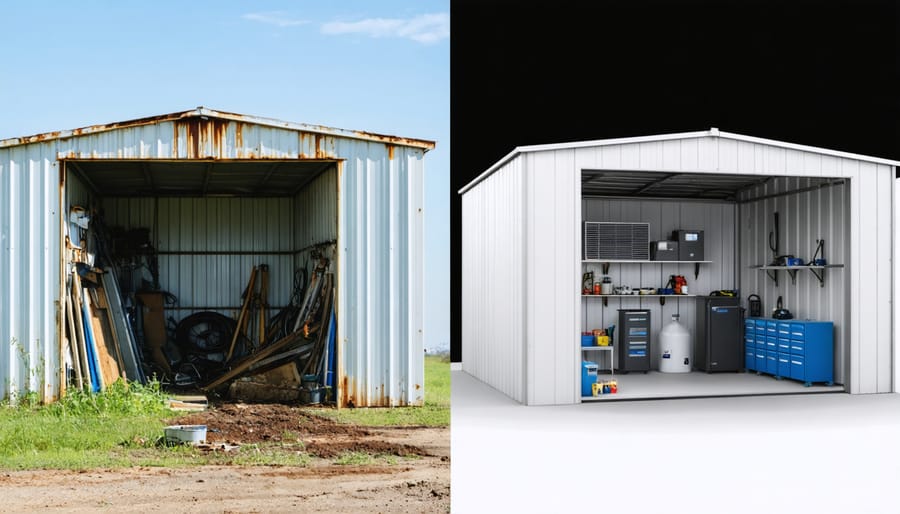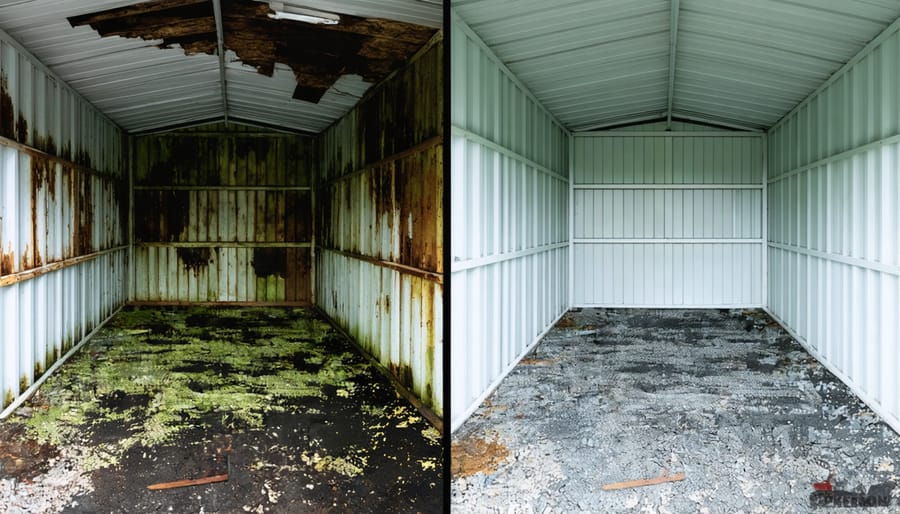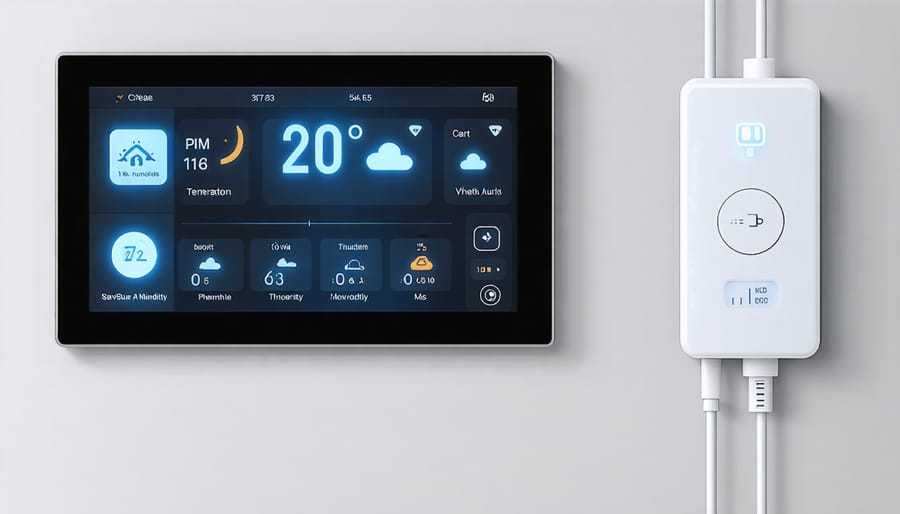Keep Your Shed Comfortable Year-Round: Smart Climate Control That Saves Money

Transform your backyard shed from a seasonal storage nightmare into a year-round functional space with modern climate control solutions. Whether protecting valuable tools, creating a workshop, or establishing a garden prep station, maintaining optimal temperature and humidity levels prevents rust, mold, and material degradation while extending your shed’s lifespan.
Smart climate management doesn’t require complex HVAC systems or expensive renovations. Today’s energy-efficient options combine traditional wisdom with innovative technology, offering practical solutions for every budget. From solar-powered ventilation fans to programmable dehumidifiers and insulation upgrades, maintaining the perfect environment in your shed has never been more accessible or cost-effective.
This guide explores proven strategies to regulate your shed’s temperature and humidity levels, helping you protect your investments while creating a comfortable, usable space in every season. Learn how strategic ventilation, proper insulation, and automated climate control systems work together to maintain ideal conditions, regardless of outside weather extremes.
Why Your Shed Needs Climate Control
Protecting Your Valuables
Extreme temperatures and humidity in your shed can wreak havoc on your stored belongings. High humidity levels can cause rust on metal tools, encourage mold growth on fabrics, and warp wooden furniture. Similarly, excessive heat can damage electronics, melt plastics, and cause paint to bubble or peel. Cold temperatures aren’t much better, potentially causing batteries to fail and materials to become brittle. Fluctuating conditions are particularly problematic, as the constant expansion and contraction of materials can lead to permanent damage. That’s why maintaining consistent temperature and humidity levels is crucial for protecting everything from power tools to holiday decorations. Consider using moisture-absorbing products and ensuring proper ventilation to maintain optimal conditions for your valuable items.

Energy Efficiency Benefits
Proper climate control in your shed isn’t just about protecting your belongings – it’s a smart investment that pays off in multiple ways. By implementing energy-saving upgrades for sheds, you can reduce your monthly utility bills by up to 30%. Well-regulated temperatures mean your heating and cooling systems work less, extending their lifespan and reducing maintenance costs. Plus, there’s the environmental impact to consider – efficient climate control means lower energy consumption and a reduced carbon footprint. Many homeowners report seeing savings within the first few months of implementing proper insulation and ventilation systems. Beyond the financial benefits, you’ll also enjoy better air quality and a more comfortable space for working on projects or accessing stored items year-round.
Eco-Friendly Climate Control Solutions
Natural Ventilation Techniques
Natural ventilation is one of the most effective and sustainable climate control methods for your shed, requiring no electricity and minimal maintenance. The key to successful natural ventilation lies in strategic vent placement and understanding airflow patterns.
Start by installing vents near the roof peak or gable ends to allow hot air to escape naturally, as warm air rises. Complement these with lower vents near the foundation to create a chimney effect that draws in cooler air from below. For optimal airflow, position your vents on opposite walls, considering the prevailing wind direction in your area.
Ridge vents running along the roof’s peak offer excellent continuous ventilation while maintaining your shed’s weather resistance. Soffit vents installed under the eaves provide additional airflow and help prevent moisture buildup in the roof space.
Consider adding adjustable vents that you can open or close depending on weather conditions. Window vents with screens are particularly useful, offering both ventilation and natural light while keeping insects out. For larger sheds, turbine vents (wind-powered) can enhance air circulation without requiring power.
Remember to keep the area around your vents clear of stored items to maintain proper airflow. Regular cleaning of vent covers and screens ensures they continue working effectively throughout the seasons.

Solar-Powered Options
Solar-powered climate control options offer an eco-friendly and cost-effective way to regulate your shed’s environment without increasing your energy bills. These solutions harness the sun’s power, making them particularly effective during hot summer months when ventilation needs are highest.
Solar-powered fans are a popular choice among shed owners, offering reliable ventilation without complex installation. These fans typically mount directly to your roof or gable and start working automatically when sunlight hits their solar panels. Many models come with built-in thermostats, activating only when temperatures rise above a certain point.
Solar vents take this concept further by combining ventilation with smart temperature regulation. These units often feature moisture sensors and adjustable settings, helping maintain optimal conditions for your stored items. Some advanced models even include remote monitoring capabilities through smartphone apps, letting you track your shed’s climate from anywhere.
For humid environments, solar-powered dehumidifiers provide an excellent solution. While less common than fans or vents, these units effectively remove excess moisture without requiring traditional power sources. They work best when paired with proper ventilation systems, creating a comprehensive climate control solution.
When selecting solar-powered options, consider your local climate and typical sunlight exposure. Most units include small backup batteries for cloudy days, but positioning your solar panels for maximum sun exposure will ensure optimal performance year-round.
Insulation Solutions
Choosing the right insulation solutions for your shed is crucial for maintaining optimal temperature control while being environmentally conscious. Natural fiber materials like sheep’s wool and recycled cotton offer excellent thermal properties while remaining eco-friendly. These materials are not only sustainable but also provide superior moisture management, helping prevent condensation and mold growth.
For walls and ceiling insulation, consider cellulose made from recycled paper products. It’s treated with natural fire retardants and pest deterrents, making it both safe and effective. Cork insulation boards are another excellent option, offering natural water resistance and thermal properties while being harvested sustainably from cork oak trees.
Installation is straightforward for most DIY enthusiasts. Start by creating a vapor barrier using recycled polyethylene sheets, then install your chosen insulation between wall studs and ceiling joists. For maximum effectiveness, ensure there are no gaps or compressed areas. Don’t forget to insulate the floor using rigid foam boards made from recycled materials or natural cork panels.
Remember to pay special attention to areas around windows, doors, and any utility penetrations. Using eco-friendly weatherstripping and sustainable caulking materials will help maintain the integrity of your insulation system while keeping your shed’s carbon footprint minimal.
Smart Monitoring and Automation
Temperature and Humidity Sensors
Keeping track of your shed’s internal climate is essential for protecting your stored items, and that’s where temperature and humidity sensors come in handy. These smart devices act as your eyes and ears when you’re not around, providing real-time information about conditions inside your shed.
Modern sensors are typically wireless and can connect to your smartphone, sending alerts when conditions fall outside your preset ranges. Many models offer both temperature and humidity readings in one compact unit, making them a practical choice for shed owners. Some advanced options even track data over time, helping you identify patterns and adjust your climate control strategy accordingly.
For best results, place sensors at different heights in your shed, as temperatures can vary significantly from floor to ceiling. Consider installing one near valuable items or in areas prone to moisture buildup. While basic models start at around $20, smart sensors with remote monitoring capabilities usually range from $30 to $60 – a small investment for the peace of mind they provide in protecting your stored belongings.
Automated Climate Control Systems
Modern automated climate control systems have revolutionized the way we manage shed environments. These smart systems use sensors to monitor temperature, humidity, and air quality, making automatic adjustments to maintain optimal conditions for your stored items. A typical setup includes programmable thermostats connected to ventilation fans, dehumidifiers, and heating units that work together seamlessly.
Many systems now offer smartphone connectivity, allowing you to monitor and adjust your shed’s climate from anywhere. You can receive alerts when conditions fall outside your specified range and make immediate adjustments through your phone. Some advanced systems even learn from your preferences and seasonal patterns, automatically adapting to weather changes.
Installation is usually straightforward, with wireless sensors that can be placed throughout your shed to ensure even climate control. These systems can be particularly valuable for protecting sensitive items like power tools, electronics, or garden chemicals from extreme temperatures and moisture damage. While the initial investment might be higher than manual solutions, the convenience and precise control they offer make them increasingly popular among shed owners who want a hands-off approach to climate management.

Creating a comfortable and controlled environment in your shed doesn’t have to be complicated or expensive. By implementing a combination of passive and active climate control solutions, you can protect your belongings while being mindful of energy consumption and environmental impact. Start with basic improvements like proper insulation and weatherstripping, then gradually incorporate more advanced solutions as needed.
Remember that even small changes can make a significant difference. Adding ventilation, using reflective materials, or installing a smart temperature monitoring system can transform your shed into a year-round functional space. The key is choosing solutions that match your specific needs and climate conditions.
Consider starting with cost-effective, sustainable options before investing in powered systems. When you do need active climate control, look for energy-efficient models and consider solar-powered alternatives. By taking a thoughtful approach to shed climate control, you’ll not only protect your stored items but also contribute to a more sustainable future while keeping your energy bills in check.
Your shed can be both functional and environmentally friendly – it’s all about finding the right balance for your situation. Take action today to create a better storage environment for tomorrow.

